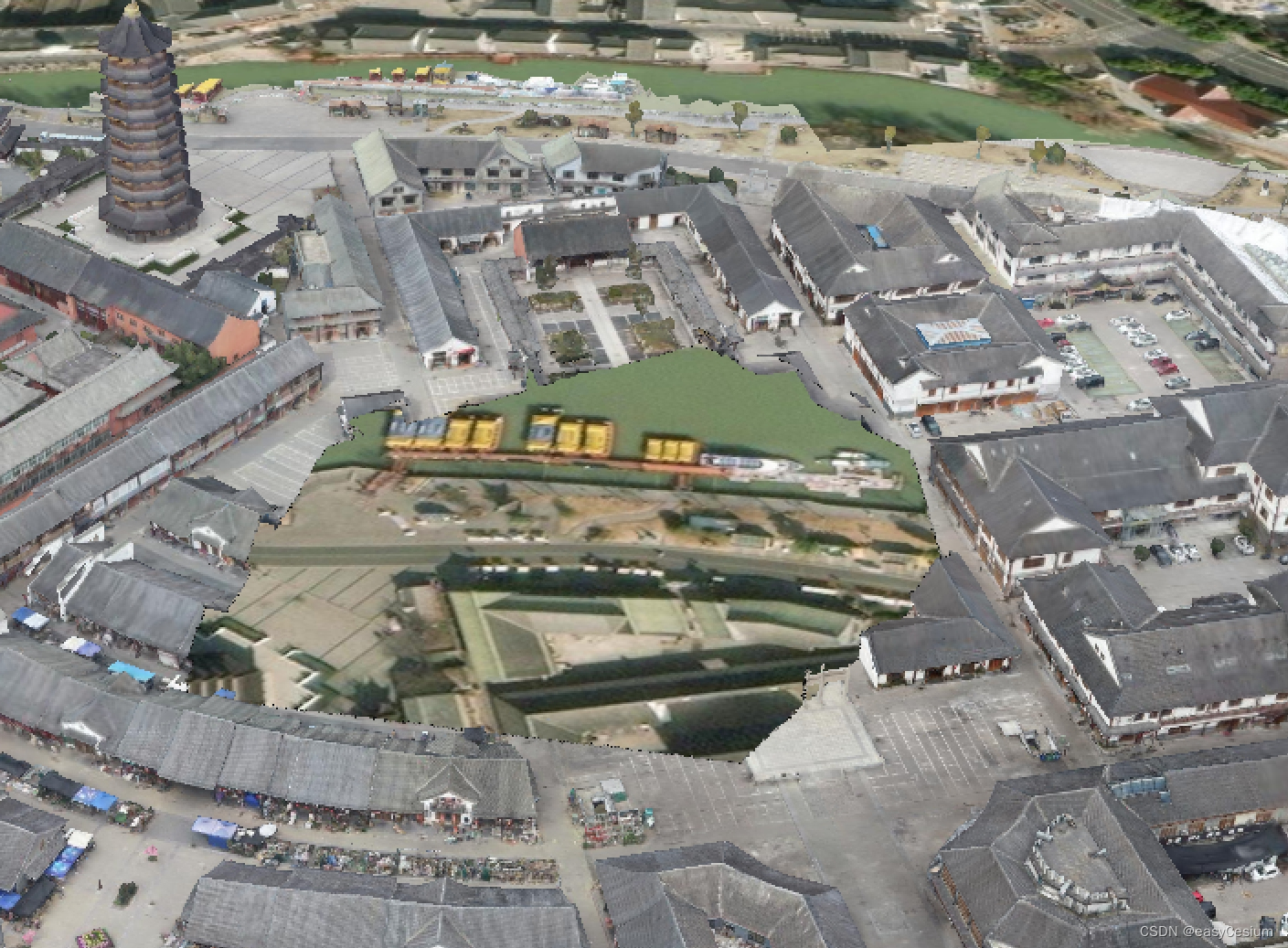Cesium 模型开挖
发布时间:2024年01月11日
和模型压平类似,此处开挖也是采用修改了模型的顶点,通过判断定的位置来判断改顶点是否加载。
缺点:会有毛边。
后续我会再上个修改源码无毛边的版本。
// 三维模型裁剪
class TilesetCut {
constructor(tileset, opt) {
if (!tileset) {
console.log("缺少模型");
return;
}
this.tileset = tileset;
this.opt = opt || {};
/**
* @property {Boolean} iscutOutter 是否为外部裁剪,默认为内部裁剪
*/
this._iscutOutter = this.opt.iscutOutter; // 是否为外部裁剪 默认为内部裁剪
this.cutRegions = []; // 当前裁剪面数组对象
/* this.modelMatrix = new Cesium.Matrix4(); // 世界坐标系--》模型坐标系
Cesium.Matrix4.inverseTransformation(this.tileset.root.computedTransform, this.modelMatrix) */
// 建立模型中心点坐标系
const center = this.tileset.boundingSphere.center;
const enuMtx4 = Cesium.Transforms.eastNorthUpToFixedFrame(center);
this.modelMatrix = Cesium.Matrix4.inverse(enuMtx4, new Cesium.Matrix4());
this.canvas = undefined;
}
get iscutOutter() {
return this._iscutOutter
}
set iscutOutter(val) {
this._iscutOutter = val;
this.updateShader();
}
/**
* 添加裁剪面
* @param {Object} attr 参数
* @param {Cesium.Cartesian3[]} attr.positions 压平面坐标
* @param {Number} attr.id 唯一标识
*/
addRegion(attr) {
let { positions, id } = attr || {};
if (!id) id = (new Date()).getTime() + "" + Number(Math.random() * 1000).toFixed(0);
if (!positions || positions.length < 3) {
console.log("缺少裁剪面坐标");
return;
}
const index = this.cutRegions.findIndex(item => item.id === id)
if (index == -1) {
this.cutRegions.push({
id: id,
positions: positions
})
} else {
this.cutRegions[index].positions = positions;
}
this.updateShader()
}
/**
* 移除裁剪面
* @param {String} id
*/
removeRegionById(id) {
if (id) { // 表示移除所有的裁剪面
const index = this.cutRegions.findIndex(item => item.id === id)
if (index != -1) this.cutRegions.splice(index, 1)
} else { // 表示移除单个的裁剪面
this.cutRegions = [];
}
this.updateShader();
}
/**
* 销毁
*/
destroy() {
this.tileset.customShader = undefined;
}
/**
* 修改模型着色器
*/
updateShader() {
debugger
// 定义着色器中裁剪函数
const fs_textureMapRect = `
vec4 textureMapRect(vec4 rect, sampler2D map, vec2 xy) {
// 判断当前图元坐标和多边形关系 如果在多边形内 进行纹素拾取
if (xy.x >= rect.x && xy.x <= rect.z && xy.y >= rect.y && xy.y <= rect.w) {
float w = rect.z - rect.x;
float h = rect.w - rect.y;
float s = (xy.x - rect.x) / w;
float t = (xy.y - rect.y) / h;
vec4 color = texture(map, vec2(s, 1.0 - t));
return color;
}
return vec4(1.0);
}
`;
let allUniforms = {
u_inverseModel: {
type: Cesium.UniformType.MAT4,
value: this.modelMatrix.clone()
},
u_unionCutRegions: {
type: Cesium.UniformType.BOOL,
value: this._iscutOutter
}
}
// 构建多区域着色器
let fs = ``;
this.cutRegions.forEach(element => {
const uniforms = this.createUniforms(element.positions, element.id)
allUniforms = Cesium.combine(allUniforms, uniforms)
fs += `
vec4 color_${element.id} = textureMapRect(u_rect_${element.id}, u_map_${element.id}, xy);
cutColor *= color_${element.id};
`
})
fs += `
if (u_unionCutRegions) {
material.diffuse *= (vec3(1.0) - cutColor.rgb);
} else {
material.diffuse *= cutColor.rgb;
}
if (material.diffuse.r <= 0.0001 && material.diffuse.g <= 0.0001 && material.diffuse.b <= 0.0001) {
discard;
}
`;
this.tileset.customShader = new Cesium.CustomShader({
uniforms: allUniforms,
fragmentShaderText: `
${fs_textureMapRect}
void fragmentMain(FragmentInput fsInput, inout czm_modelMaterial material) {
vec4 positionMC = u_inverseModel * vec4(fsInput.attributes.positionWC, 1.0);
vec2 xy = positionMC.xy;
vec4 cutColor = vec4(1.0);
${fs}
}`
})
}
/**
* 根据坐标创建片元着色器
* @param {Cartesian3[]} positions
* @param {String} id
*/
createUniforms(positions, id) {
if (!positions || positions.length < 3) {
console.log("缺少裁剪面坐标");
return;
}
id = id || Math.ceil(Math.random() * 100000) + '_' + Math.ceil(Math.random() * 100000)
// 根据世界坐标范围计算相对模型坐标范围
const xs = [], ys = [], zs = []
// 计算模型坐标系下坐标
const modelPoints = positions.map(p => {
const point = Cesium.Matrix4.multiplyByPoint(this.modelMatrix, p, new Cesium.Cartesian3());
xs.push(point.x)
ys.push(point.y)
zs.push(point.z)
return point
})
// 计算当前裁剪面边界范围(模型坐标系下)
const rect = new Cesium.Cartesian4(Math.min.apply(null, xs), Math.min.apply(null, ys), Math.max.apply(null, xs), Math.max.apply(null, ys))
const canvas = document.createElement('canvas')
canvas.width = 1024
canvas.height = 1024
const width = rect.z - rect.x
const height = rect.w - rect.y
const ctx = canvas.getContext('2d')
ctx.fillStyle = '#fff' // 设置整体背景为白色
ctx.fillRect(0, 0, canvas.width, canvas.height)
ctx.beginPath()
ctx.moveTo(canvas.width * (modelPoints[0].x - rect.x) / width, canvas.height * (modelPoints[0].y - rect.y) / height)
for (let i = 1; i < modelPoints.length; i++) {
ctx.lineTo(canvas.width * (modelPoints[i].x - rect.x) / width, canvas.height * (modelPoints[i].y - rect.y) / height)
}
ctx.closePath()
ctx.fillStyle = '#000' // 根据填充的黑色来裁剪模型
ctx.fill()
this.canvas = canvas;
const uniforms = {}
uniforms[`u_rect_${id}`] = {
type: Cesium.UniformType.VEC4,
value: rect
}
uniforms[`u_map_${id}`] = {
type: Cesium.UniformType.SAMPLER_2D,
value: new Cesium.TextureUniform({
url: canvas.toDataURL()
}),
minificationFilter: Cesium.TextureMinificationFilter.LINEAR,
magnificationFilter: Cesium.TextureMagnificationFilter.LINEAR
}
return uniforms
}
}
export default TilesetCut调用方式:
?
let cutTool = new Cut(tileset);
cutTool.addRegion({
positions : positions,
id : new Date().getTime()
});
文章来源:https://blog.csdn.net/caozl1132/article/details/135533874
本文来自互联网用户投稿,该文观点仅代表作者本人,不代表本站立场。本站仅提供信息存储空间服务,不拥有所有权,不承担相关法律责任。 如若内容造成侵权/违法违规/事实不符,请联系我的编程经验分享网邮箱:chenni525@qq.com进行投诉反馈,一经查实,立即删除!
本文来自互联网用户投稿,该文观点仅代表作者本人,不代表本站立场。本站仅提供信息存储空间服务,不拥有所有权,不承担相关法律责任。 如若内容造成侵权/违法违规/事实不符,请联系我的编程经验分享网邮箱:chenni525@qq.com进行投诉反馈,一经查实,立即删除!
最新文章
- Python教程
- 深入理解 MySQL 中的 HAVING 关键字和聚合函数
- Qt之QChar编码(1)
- MyBatis入门基础篇
- 用Python脚本实现FFmpeg批量转换
- STM32——DMA知识点及实战总结
- java中解码和编码出现乱码原因
- Grafana Loki 日志传输工具
- 计算机网络 - 路由器查表过程模拟 C++(2024)
- Arduino平台软硬件原理及使用——按键模块(下拉电阻电路)的使用
- 在Flutter中使用PhotoViewGallery指南
- ssm/php/node/python环保小卫士app(源码+mysql+文档)
- c语言-枚举和联合体
- TSP(Python):Qlearning求解旅行商问题TSP(提供Python代码)
- springboot学生成绩管理系统源码和论文